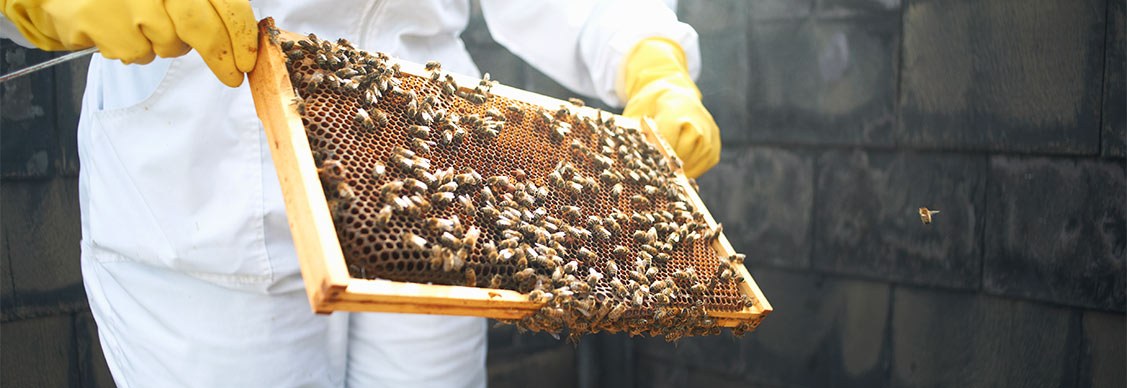Why the rooftops are alive with the buzz of bees
Beehives on the roofs of commercial and residential buildings are quietly becoming more common
Let’s shape the future of work
Ideas, research and solutions to address the tough questions facing business leaders today.
City rooftops may not be the most obvious place to home colonies of bees.
But amid growing efforts to bring nature back into urban areas, there’s a buzzing new world emerging high above the apartments, office desks and hotel rooms of today’s high-rise buildings across global cities.
The rooftops of the Bank of America Plaza in Los Angeles, Brookfield Place in Manhattan and the Houston Center are just some of the Brookland Properties owned buildings to recently install professionally-managed bee hives. Last year Goldman Sachs Asset Management similarly partnered with Canadian urban beekeeping firm Alvéole to bring a buzz to more than 30 of its buildings – and tenants can even track the health of bees online.
In the UK, JLL’s Manchester office has two hives, each hosting 70,000 bees while over in France, Prologis has long positioned hives near its industrial facilities.
Rapid urbanisation has accentuated the need to increase biodiversity to help improve air and water quality and keep cities cooler as temperatures rise, says Jeremy Kelly, Global Research Director at JLL.
He points to the likes of Melbourne’s Urban Forest Strategy and efforts by Paris to put green roofs at the centre of its green transformation. Others such as London’s Wild West End partnership, backed by Grosvenor Britain & Ireland and The Portland Estate among others, are encouraging birds and insects back into the capital’s green corridor
“Cities are increasingly measuring their biodiversity and coming up with new ways to integrate it into urban planning,” Kelly says. “Introducing bees and creating new rooftop habitats improve the overall resilience of cities to climate change.”
Part of city life
Insects pollinate more than 80 percent of crop species in Europe, including most fruits, many vegetables, and some biofuel crops; honeybees are among the most important pollinators.
A study by the University of Reading estimates that globally, bees’ pollination service has an economic value of approximately £120 billion (US$169 billion) and an annual value to the UK alone of around £690 million.
But in recent years, they’ve needed human help to get their work done. Oslo was the world’s first city to help save bees in 2015 with its bee highway, while in Germany, eight colonies of bees were introduced to the roof of a LaSalle Investment Management shopping centre in Darmstadt in 2019.
Over in the UK, five hives housing some 300,000 bees sit in the Crown Estate’s Princesshay rooftop garden in Exeter as part of a wider initiative which includes a garden of herbs and fruit trees. The bees’ honey is then sold in the shopping centre below. In a similar vein, the colonies of bees living atop Hilton hotels in the likes of Brisbane, New York’s Midtown and San Diego provide honey for their restaurants.
Looking for more insights? Never miss an update.
The latest news, insights and opportunities from global commercial real estate markets straight to your inbox.
Rethinking roofs
More real estate owners are now thinking about how they can put their urban rooftops to good use as part of their wider sustainability plans.
“Beehives and bee-friendly building methods are only one part of the wider biodiversity effort,” says Amanda Skeldon, Climate & Nature Director at JLL UK. “A green rooftop means bees can happily pollinate, while delivering benefits for a building’s immediate community, from local food sourcing to improved air quality.”
The increased focus on making office buildings more pleasant places to be for employees has brought a range of biodiversity strategies to the fore, she adds. Rooftop gardens featuring a range of plants, living walls and walking trails through outside space are becoming more popular.
As further legislation rolls out – for example, enhancing biodiversity will become a fundamental part of the development process in England in 2023, incorporating biodiversity early is a smart choice, Skeldon explains.
“Homebuilders will soon be asked to offset their biodiversity impact on all developments – and incorporating measures early could save on costly offsetting outlays, which is expected to be higher than the alternative of simply putting more green space into their initial building plans,” she says. “For clients, particularly developers, it is proving that biodiversity pays.”
Let’s shape the future of work
Ideas, research and solutions to address the tough questions facing business leaders today.
In the UK, many local authorities are already taking steps to support biodiversity. New planning rules in Brighton and Hove stipulate that all buildings above five metres should include bee bricks and support bird nesting while in Hackney, London, new build projects require swift bricks to allow safe nesting areas.
For investors, Kelly says the focus is largely on net zero carbon but they’re starting to talk more about biodiversity as more buildings that incorporate green space in innovative ways emerge, from Milan’s Bosco Verticale to the Mille Arbres mega project in Paris.
“There’s now a definite shift towards the quality of that greenness now,” he says. And on World Bee Day (20 May), that’s welcome news for bees.
